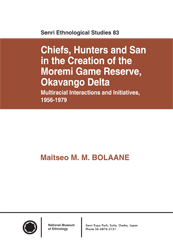Senri Ethnological Studies (SES)
 No. 83 Chiefs, Hunters and San in the Creation of the Moremi Game Reserve, Okavango Delta; Multiracial Interactions and Initiatives, 1956-1979
No. 83 Chiefs, Hunters and San in the Creation of the Moremi Game Reserve, Okavango Delta; Multiracial Interactions and Initiatives, 1956-1979
June 10, 2013 Publication
MAITSEO M. M. BOLAANE
back numbersPreface and Acknowledgements
Abbreviations and Acronyms
Glossary of Setswana Terms
Introduction
- 1. Introduction
- 2. Historiographic Contribution
- 3. Community Management and Moremi
- 4. National Parks vs. Game Reserves: the Botswana context
- 5. Tourism in the Okavango Delta and Moremi
Chapter 1:
The History of Wildlife Conservation and Management in Africa and
in the Context of BOTSWANA
- 1. Introduction
- 2. The Evolution of Game Conservation
- 3. Local Involvement in Conservation-related Activity: A Humanistic Perspective?
- 4. Settlement and Political Control of Okavango
- 5. Historical Controls Over Hunting and Wildlife
- 6. Summary
Chapter 2:
Tsetse and Trypanosomosis Control in the Okavango Delta: 1930s–1960s
- 1. Introduction
- 2. Cause and Effects of Disease
- 3. Tsetse Fly Patterns in Northern Botswana
- 4. Incidence of Disease
- 5. Expanding Fly Belts: Tsetse Becomes a 'colonial matter': 1920s–1940s
- 6. The Tsetse Control Department and its Operations
- 7. The Period of Discriminative Bush Clearing
- 8. Tsetse Control and Wider Development Planning in Ngamiland
- 9. Game Reserves, Hunting and Tsetse Eradication
- 10. Game Policy and Promotion of the Safari Industry and the Creation of Game Reserves
Chapter 3:
Key Players: Achieving Consensus on the Fauna Conservation Society and
Moremi Game Reserve
- 1. Introduction
- 2. June and Robert Kay—White Hunters Turned Conservationists
- 3. Crocodile Hunting
- 4. The Local Skills and Knowledge of the 'River San/BaSarwa'
- 5. The Relationship between the Kays and the Officials
- 6. The Kays and the Tawana Tribal Authority
- 7. Concerns about Illicit Hunting Activities in the Khwai Region
- 8. The Formation of the Fauna Preservation Society of Ngamiland
- 9. Official Response—Getting the Africans and White Residents of Maun to Accept the Fauna Preservation Society in Ngamiland
- 10. Second Formal Meeting of the Society at Riley's Hotel: African Support
Chapter 4:
The Fauna Conservation Society, the Kgotla and the Government
- 1. Introduction
- 2. The kgotla
- 3. The BaTawana Tribal Council
- 4. The kgotla and Tribal Council Approval of the Fauna Preservation Society in Ngamiland
- 5. Official Launching of the Fauna Preservation Society of Ngamiland and the Plan of Action
- 6. Local Government Officials, Safari Firms and the Park
- 7. African 'house-to-house' Campaign Strategy for the Creation of a Game Reserve and the Government's Change of Heart
- 8. The Riney/Hill FAO/IUCN Report
- 9. 'Weight Carriers' and the Projected Game Reserve
Chapter 5:
Control and Management of the Moremi Game Reserve in the Early 1960s
- 1. Introduction
- 2. The Physical Environment of Moremi
- 3. The Park Regulations
- 4. The Boundaries and Policing
- 5. From 'preservation' to 'conservation', and the Tourism Policy
- 6. South African and International Interest
- 7. The Tinley/Deane Ecological Survey
Chapter 6:
Conflicts over Financial and Technical Control: the Kays, the WWF,
the Fauna Conservation Society and the Government
- 1. Introduction
- 2. Financial Problems
- 3. Anti-Kay Sentiment
- 4. The FCS and the WWF
- 5. The Tinley Report
- 6. Postscript: the FCS after Independence
Chapter 7:
The Basarwa of the Okavango Delta and the Park: the Case of the Bugakhwe
- 1. Introduction
- 2. The BaSarwa Concept of Territoriality and their Occupation of the Okavango
- 3. Traditional Subsistence Strategies: Movements between the Riverine Area and Sandveld
- 4. Bugakhwe Neighbours in 'old Khwai' and Tsetse
- 5. Significance of the Xuku Floodplains (Hippo pools)
- 6. BaSarwa Perceptions and Memories of the Foundation of Moremi
- 7. Summary




